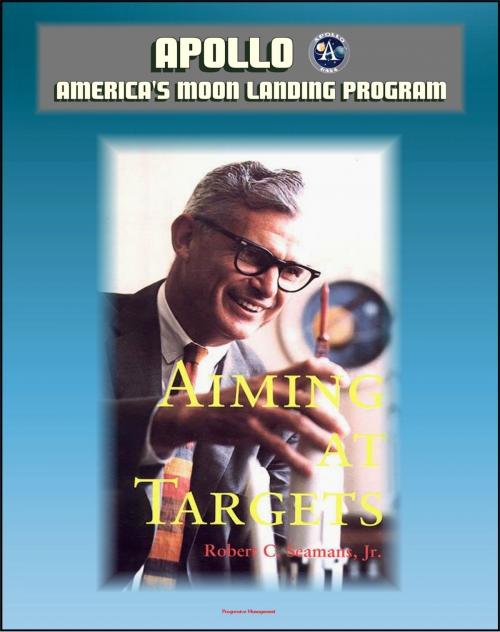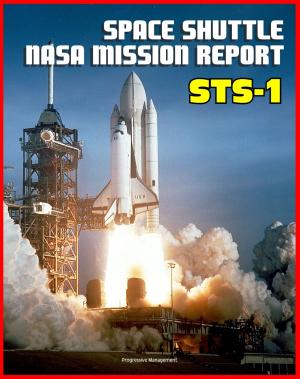Apollo and America's Moon Landing Program - Aiming At Targets - The Autobiography Of Robert C. Seamans, Jr. (NASA SP-4106) Incisive Commentary on Apollo, the Apollo 1 Fire, Space Program Management
Nonfiction, Science & Nature, Science, Physics, Astronomy, Social & Cultural Studies, Political Science, Government| Author: | Progressive Management | ISBN: | 9781465937803 |
| Publisher: | Progressive Management | Publication: | December 1, 2011 |
| Imprint: | Smashwords Edition | Language: | English |
| Author: | Progressive Management |
| ISBN: | 9781465937803 |
| Publisher: | Progressive Management |
| Publication: | December 1, 2011 |
| Imprint: | Smashwords Edition |
| Language: | English |
This official NASA history document - converted for accurate flowing-text e-book format reproduction - was written by one of the giants of the Apollo program, Robert C. Seamans, Jr., the Associate Administrator of NASA from 1960 through 1967. He tells fascinating accounts of critical moments in the program, including the Kennedy decision to go to the moon, JFK's assassination, Lyndon Johnson's support of the effort and interest in using astronauts for overseas good will tours, struggles over budgets and personnel, the aftermath of the tragic Apollo 1 fire, controversies over Congressional testimony and media statements, his relationship with NASA Administrator Jim Webb, and much more.
The foreword by Willis Shapley, "Bob Seamans originally was inspired to write this book for his family and friends. That is a large audience. By his own count his immediate family numbers twenty-four, not counting brothers and cousins and their families. His friends are uncounted but surely run to hundreds. As one of them and as a colleague at NASA, I am pleased and honored that he asked me to write this foreword. While written in Bob's unique and informal style, this autobiography has significance for many readers beyond his large circles of family and friends. Leaders and students of large, complex technological endeavors should be able to learn much from reading how Bob faced the daunting technical and management challenges in his career. As the title of this book implies, Bob has always set high goals for himself and then kept his eyes focused on both the necessary details and the broader picture. His ability to shift smoothly among jobs that required seemingly disparate abilities and skills speaks volumes about his insight, dedication, and enthusiasm for achievement. The book spans a truly remarkable life story. Bob first takes us through his growing up, education, and early professional and family life. Next he focuses on the crucial years when he was the general manager of NASA. Then he moves on to his career in the top jobs at the Air Force, the National Academy of Engineering, and the Energy Research and Development Administration. Finally, he touches on his later leadership activities in the academic and business worlds. Aiming at Targets is a series of fascinating topical vignettes covering his professional life. Taken together, like broad brushstrokes in an impressionist painting, they give a better picture of Bob Seamans and his work than a detailed recitation of facts and dates could hope to do. This is a cheerful account of an interesting and successful career. The book is full of good stories, with many memorable characters. Like the proverbial sundial, it counts the sunny hours. It is a good read. But it has its serious side. Bob's career wasn't all fun. The Apollo 204 fire, which killed three astronauts, was a terrible climax to his time at NASA. As one who lived through those days with him, I can recall the trauma and special sense of responsibility he felt. His account of this period and of the sad deterioration of his relationship with his boss, Jim Webb, is both fair and generous. Those were not happy times, but they should not be allowed to overshadow the fact that in his seven years at NASA, Bob Seamans led the agency to its first successes and laid the groundwork for the greater successes that came later."
This official NASA history document - converted for accurate flowing-text e-book format reproduction - was written by one of the giants of the Apollo program, Robert C. Seamans, Jr., the Associate Administrator of NASA from 1960 through 1967. He tells fascinating accounts of critical moments in the program, including the Kennedy decision to go to the moon, JFK's assassination, Lyndon Johnson's support of the effort and interest in using astronauts for overseas good will tours, struggles over budgets and personnel, the aftermath of the tragic Apollo 1 fire, controversies over Congressional testimony and media statements, his relationship with NASA Administrator Jim Webb, and much more.
The foreword by Willis Shapley, "Bob Seamans originally was inspired to write this book for his family and friends. That is a large audience. By his own count his immediate family numbers twenty-four, not counting brothers and cousins and their families. His friends are uncounted but surely run to hundreds. As one of them and as a colleague at NASA, I am pleased and honored that he asked me to write this foreword. While written in Bob's unique and informal style, this autobiography has significance for many readers beyond his large circles of family and friends. Leaders and students of large, complex technological endeavors should be able to learn much from reading how Bob faced the daunting technical and management challenges in his career. As the title of this book implies, Bob has always set high goals for himself and then kept his eyes focused on both the necessary details and the broader picture. His ability to shift smoothly among jobs that required seemingly disparate abilities and skills speaks volumes about his insight, dedication, and enthusiasm for achievement. The book spans a truly remarkable life story. Bob first takes us through his growing up, education, and early professional and family life. Next he focuses on the crucial years when he was the general manager of NASA. Then he moves on to his career in the top jobs at the Air Force, the National Academy of Engineering, and the Energy Research and Development Administration. Finally, he touches on his later leadership activities in the academic and business worlds. Aiming at Targets is a series of fascinating topical vignettes covering his professional life. Taken together, like broad brushstrokes in an impressionist painting, they give a better picture of Bob Seamans and his work than a detailed recitation of facts and dates could hope to do. This is a cheerful account of an interesting and successful career. The book is full of good stories, with many memorable characters. Like the proverbial sundial, it counts the sunny hours. It is a good read. But it has its serious side. Bob's career wasn't all fun. The Apollo 204 fire, which killed three astronauts, was a terrible climax to his time at NASA. As one who lived through those days with him, I can recall the trauma and special sense of responsibility he felt. His account of this period and of the sad deterioration of his relationship with his boss, Jim Webb, is both fair and generous. Those were not happy times, but they should not be allowed to overshadow the fact that in his seven years at NASA, Bob Seamans led the agency to its first successes and laid the groundwork for the greater successes that came later."















